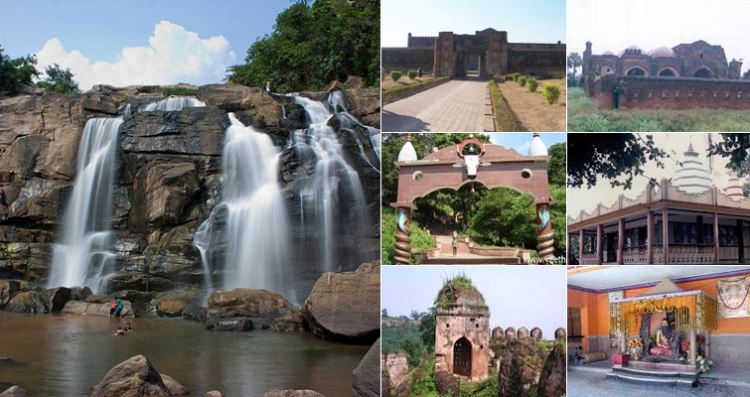Jharkhand, often called the “Land of Forests”, is one of India’s most underrated yet fascinating travel destinations. Formed in 2000 after being separated from Bihar, the state has quickly established itself as a center of natural beauty, tribal heritage, spiritual destinations, and eco-tourism.
While most Indian travelers are drawn to the Himalayas, Rajasthan, or Kerala, those who visit Jharkhand are pleasantly surprised by its lush green forests, stunning waterfalls, ancient temples, and unique tribal traditions. It is a land where nature and culture exist in harmony — where waterfalls cascade down cliffs, where sacred temples sit atop hills, and where tribal communities preserve age-old traditions.
In this blog explores Jharkhand Tourism in detail — from its history and culture to its top destinations, wildlife sanctuaries, religious centers, festivals, food, and travel itineraries.
Table of Contents
1. History and Cultural Background of Jharkhand
The word “Jharkhand” comes from the Hindi words “Jhar” (forest) and “Khand” (land), meaning “land of forests.” Historically, it has been home to many tribal communities, each with its own language, customs, and traditions.
Ancient scripts and archaeological sites show evidence of settlements dating back to the Stone Age.
The region was ruled by the Nagvanshi dynasty and later influenced by the Mughals and the British.
It has also been a major center for the freedom struggle, with leaders like Birsa Munda leading tribal uprisings against British rule.
Today, Jharkhand’s culture reflects this rich blend of tribal heritage, folk traditions, and modern development.
2. Geography and Climate
Jharkhand lies on the Chota Nagpur Plateau, blessed with:
Forests: Covering 30% of its land area.
Waterfalls: Some of India’s most beautiful cascades.
Rivers: Damodar, Subarnarekha, Koel, and Barakar.
Minerals: Rich deposits of coal, iron, and mica.
Climate:
Summer: Hot (30°C–40°C)
Monsoon: Lush greenery, heavy rainfall (Jul–Sept)
Winter: Pleasant and cool (8°C–22°C), best for tourism
3. Major Tourist Attractions in Jharkhand
3.1 Waterfalls of Jharkhand
Jharkhand is known as the “Waterfall State of India” because of its breathtaking falls:
Dassam Falls (Ranchi): 144 ft high, popular picnic spot.
Hundru Falls (Ranchi): Tallest waterfall in Jharkhand at 320 ft.
Jonha Falls (Ranchi): Also called Gautamdhara, perfect for swimming.
Panchghagh Falls (Khunti): Five streams cascading together.
Lodh Falls (Latehar): Highest in Jharkhand at 469 ft.
3.2 Lakes and Dams
Patratu Dam & Valley (Ramgarh): Scenic road and boating.
Kanke Dam (Ranchi): Popular for evening outings.
Getalsud Dam (Ranchi): A major reservoir with beautiful sunsets.
3.3 Wildlife and National Parks
Jharkhand is rich in biodiversity with several tiger reserves and sanctuaries:
Betla National Park (Latehar): Part of Palamu Tiger Reserve, home to elephants, tigers, leopards.
Dalma Wildlife Sanctuary (Jamshedpur): Famous for elephants and trekking.
Hazaribagh Wildlife Sanctuary: Leopards, sambar, chital, and rich birdlife.
Palamu Tiger Reserve: Among India’s oldest tiger reserves.
3.4 Religious Tourism
Jharkhand is dotted with ancient temples and sacred sites:
Baidyanath Dham (Deoghar): One of the 12 Jyotirlingas of Lord Shiva.
Parasnath Hill (Giridih): Most sacred pilgrimage for Jains.
Rajrappa Temple (Ramgarh): Dedicated to Goddess Chhinnamasta, unique tantric temple.
Jagannath Temple (Ranchi): Built in 1691, similar to Puri’s Jagannath Temple.
Sun Temple (Ranchi): A beautiful temple shaped like a giant chariot.
3.5 Hill Stations & Scenic Spots
Netarhat (Latehar): Known as the “Queen of Chotanagpur.” Famous for sunrise/sunset points.
Parasnath Hills (Giridih): Highest peak in Jharkhand.
Ranchi Hills: Offers panoramic city views.
3.6 Heritage & Historical Places
Palamu Fort (Latehar): 17th-century ruins surrounded by forests.
Maluti Temples (Dumka): Cluster of terracotta temples.
4. Festivals of Jharkhand
Jharkhand celebrates a mix of tribal, folk, and Hindu festivals:
Sarhul: Celebrated by tribal communities in spring, honoring nature.
Karma Festival: Worship of the Karma tree, symbolizes fertility.
Sohrai: Harvest festival, houses decorated with tribal wall art.
Tusu Festival: Celebrated during Makar Sankranti with folk songs.
Durga Puja, Diwali, Chhath Puja: Celebrated with great enthusiasm.
5. Tribal Culture and Handicrafts
Jharkhand is home to over 30 tribal communities, including Santhal, Munda, Oraon, Ho, and Kharia.
Cultural Highlights:
Music & Dance: Tribal dances like Chhau, Paika, and Santhal dance.
Handicrafts: Dokra metal craft, bamboo works, wood carvings.
Tribal Paintings: Sohrai and Kohbar wall art.
Traditional Attire: Handloom textiles, ornaments made of beads and silver.
6. Adventure Tourism in Jharkhand
For thrill-seekers, Jharkhand offers:
Trekking: Dalma hills, Netarhat, Parasnath.
Rock Climbing: Jonha and Hundru Falls.
Boating: Patratu Lake, Kanke Dam.
Wildlife Safaris: Betla National Park, Hazaribagh Sanctuary.
7. Cuisine of Jharkhand
Jharkhand’s food reflects its tribal roots and agrarian lifestyle.
Dhuska: Fried rice and lentil pancake.
Pitha: Rice flour dumplings with sweet or savory fillings.
Litti-Chokha: Traditional Bihari-Jharkhandi delicacy.
Rugra & Kachri: Seasonal mushrooms, local delicacies.
Handia: Traditional rice beer, popular among tribes.
8. Best Time to Visit Jharkhand
Winter (Oct–Feb): Best season for sightseeing and festivals.
Monsoon (Jul–Sept): Beautiful greenery and waterfalls in full glory.
Summer (Mar–Jun): Hot, but hill stations like Netarhat remain pleasant.
9. Travel Itineraries
3-Day Jharkhand Tour
Day 1: Ranchi sightseeing (Dassam Falls, Hundru Falls, Jagannath Temple, Rock Garden).
Day 2: Patratu Valley, Kanke Dam, Sun Temple.
Day 3: Netarhat excursion.
7-Day Jharkhand Tour
Ranchi (falls & temples)
Deoghar (Baidyanath Jyotirlinga)
Giridih (Parasnath Hills)
Netarhat & Betla National Park
Jamshedpur (Dalma Sanctuary, Dimna Lake)
10. Travel Tips
Carry cash for remote areas; ATMs are limited.
Hire local guides for tribal villages and sanctuaries.
Respect tribal customs while visiting cultural festivals.
Winter clothing is essential during Nov–Feb.
11. Future of Jharkhand Tourism
The government is focusing on:
Developing eco-tourism circuits.
Promoting tribal culture & handicrafts.
Enhancing infrastructure & road connectivity.
Positioning Jharkhand as a nature and heritage tourism hub.
Conclusion
Jharkhand is a land waiting to be discovered — a blend of forests, waterfalls, temples, wildlife, and tribal traditions. Unlike crowded tourist destinations, Jharkhand offers a raw, authentic, and refreshing experience.
From the spiritual energy of Deoghar to the natural charm of Netarhat and Patratu, from the tribal dances of Sarhul to the roar of Lodh Falls, Jharkhand is a destination that touches both the heart and the soul.
For travelers seeking offbeat, eco-friendly, and culturally rich experiences, Jharkhand should definitely be on the bucket list.
FAQs
Q1. What is Jharkhand famous for in tourism?
A: Jharkhand is known for its waterfalls, forests, wildlife sanctuaries, religious sites, and tribal culture.
Q2. Which is the most visited place in Jharkhand?
A: Baidyanath Dham in Deoghar is the most visited pilgrimage site, while Ranchi’s waterfalls are the most popular natural attractions.
Q3. What is the best time to visit Jharkhand?
A: Winter (Oct–Feb) is ideal for tourism. Monsoon is great for waterfall lovers.
Q4. Does Jharkhand have hill stations?
A: Yes, Netarhat is known as the “Queen of Chotanagpur” and is a popular hill station.
Q5. Is Jharkhand safe for tourists?
A: Yes, most tourist areas are safe. Basic precautions should be taken while traveling to remote areas.
Q6. What are the unique festivals of Jharkhand?
A: Sarhul, Sohrai, Karma, and Tusu are unique tribal festivals of the state.
Q7. Can I do adventure activities in Jharkhand?
A: Yes, trekking, rock climbing, boating, and wildlife safaris are popular adventure options.











